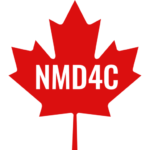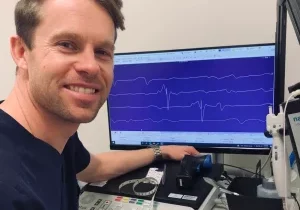Dr. Emilie Groulx-Boivin’s Early Career Blog

Dr. Emilie Groulx-Boivin completed her undergraduate degree in Physiology and her medical training at McGill University. She is currently a third-year pediatric neurology resident at the Montreal Children’s Hospital and is concurrently pursuing a Master of Science in the Integrated Program in Neuroscience at McGill. Her research focuses on structural and functional brain imaging in spinal muscular atrophy (SMA).
Under the mentorship of Dr. Maryam Oskoui, an international leader in pediatric neuromuscular disorders, Dr. Groulx-Boivin is dedicated to improving the quality of life of children with SMA and other neuromuscular conditions through early diagnosis, advanced neuroimaging, and innovative assistive technologies.
Empowering Children with Neuromuscular Disorders Through Brain – Computer Interface Technology
By Dr. Emilie Groulx-Boivin
Third-year pediatric neurology resident & MSc candidate. McGill University / Montreal Children’s Hospital.
This past August, I had the incredible opportunity to spend two weeks at the Alberta Children’s Hospital in Calgary through the 2025 NMD4C Collaborative Research Training Award. My visit focused on learning from the world-renowned pediatric Brain–Computer Interface (BCI) program led by Dr. Adam Kirton and his team at BCI-CAN. This collaboration aims to expand access to BCI technology for children living with severe neuromuscular disorders (NMDs) in Quebec.
Children affected by spinal muscular atrophy and other NMDs often experience profound motor impairments while maintaining intact cognitive abilities. These children face barriers to communication, play, and participation in everyday life. Our project, Empowering Participation in Neuromuscular Disorders, seeks to restore a sense of agency through BCI: a technology that allows users to control computers or toys directly through brain activity. By working alongside the Calgary BCI-CAN team, my goal was to acquire the technical and clinical expertise needed to establish Quebec’s first pediatric BCI program. This initiative builds upon the growing collaboration between McGill University and the University of Calgary and will allow us to evaluate how BCI can enhance engagement, goal achievement, and quality of life for children with NMDs.
During my stay, I learned how to set up, operate, and troubleshoot BCI systems directly from experienced users, including the lead occupational therapist. I observed professionals using the technology with children of different ages, varying degrees of disability, and across a wide range of health conditions. I was able to witness both individual and group sessions, and the remarkable versatility of BCI in action, from turning on a favourite song to playing online games, baking, or even competing in boccia. The highlight of each session was seeing the children’s faces light up with pride and joy as they realized what they could accomplish. Witnessing how BCI can transform moments of limitation into empowerment reinforced my commitment to bringing this technology home to Montreal. This immersive experience also gave me the chance to connect with key players in the field, including therapists, engineers, clinicians, and even local organizations that adapt standard toys for use with BCI technology. These new relationships will be instrumental as we begin implementing our own pediatric BCI program in Quebec.
Outside the lab, I explored Calgary and its surroundings: the skyline framed by the Rockies, the hike to Lake Agnes Tea House, and local favourites like Made by Marcus and Village Ice Cream. I also enjoyed connecting with trainees, physicians, and researchers from diverse backgrounds who share a common vision: improving the lives of children with neurological diseases through innovation, inclusion, and compassion.
Since returning to Montreal, I have begun applying the knowledge gained in Calgary to lay the foundation for our local BCI initiative. Our initial focus will be on expanding its use to children with neuromuscular conditions. We are currently assembling a multidisciplinary team and finalizing the purchase of BCI equipment, with the goal of launching participant recruitment in early 2026. In the long term, we aim to build a sustainable national network where children across Canada can access these transformative technologies.
I am profoundly grateful to the NMD4C for supporting this vision through the Collaborative Research Training Award, which provided not only funding but also an unforgettable and inspiring learning experience.










